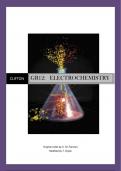Summary
Electrochemistry Summary (Grade 12 IEB)
- Course
- Institution
Electrochemistry Summary (Grade 12 IEB) INTRODUCTORY TERMINOLOGY ELECTROCHEMISTRY is the branch of chemistry that deals with the transformation between electrical and chemical energy. Galvanic cell - a device that converts chemical energy to electrical energy as a result of self-sust...
[Show more]



